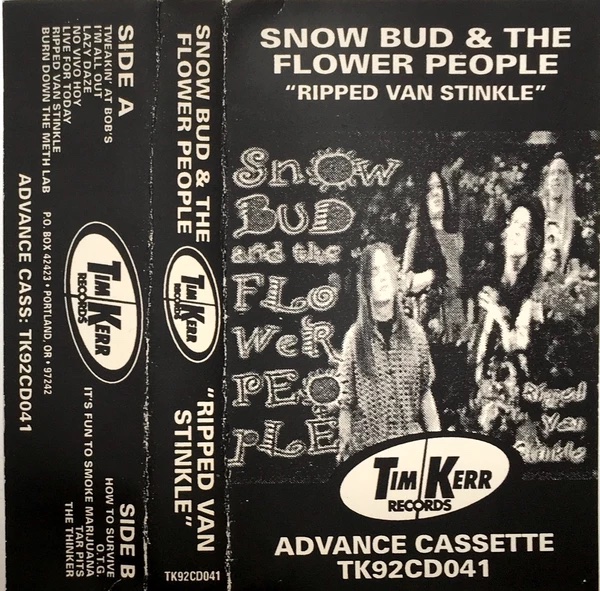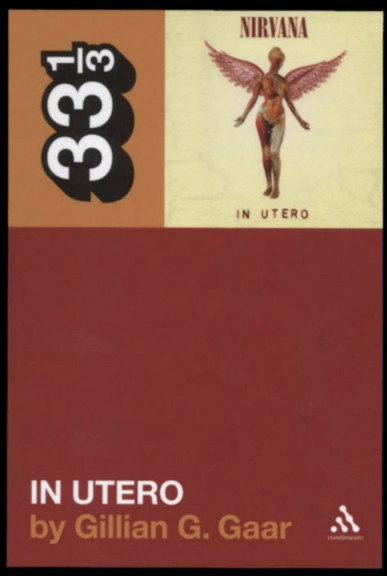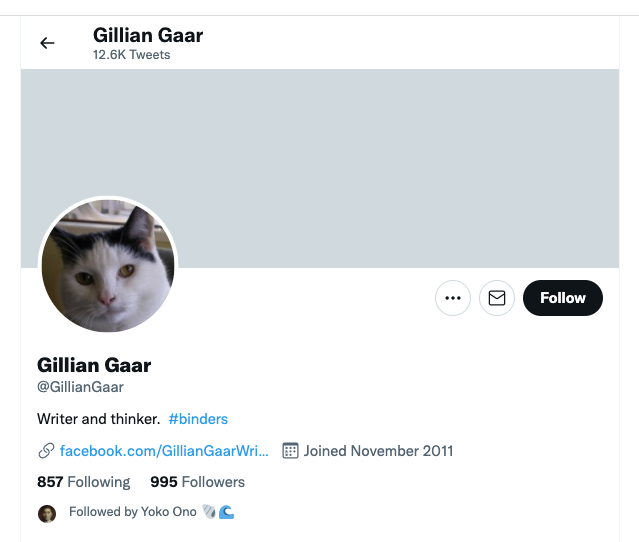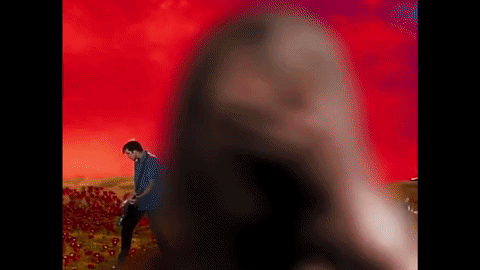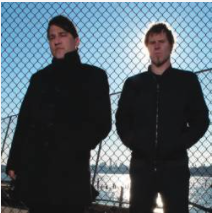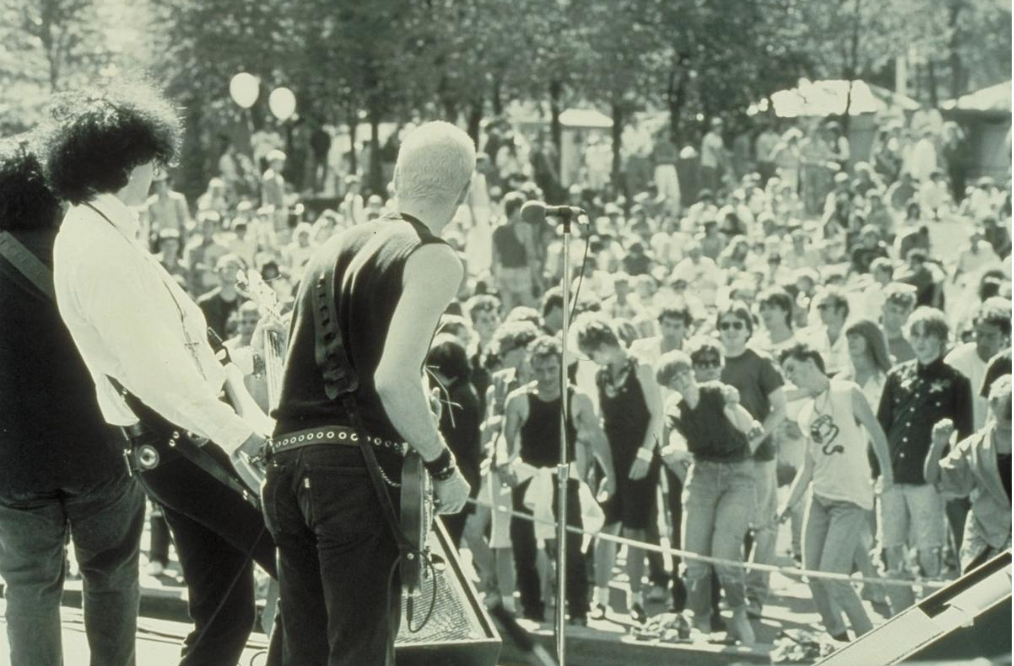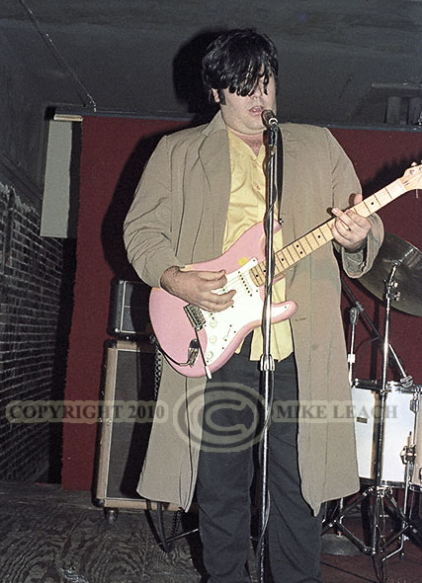Originally published September 2013 on collapseboard.com
I’ve tried to write this story, or something like it, a few times, but always got mired. Then, on July 11, something about the way two contrasting images cut across my brain – the 25-year-old daddy-band Mudhoney surfing across the blue skies of Seattle, while the 33-year-old granddaddy-band Napalm Beach says farewell from deep inside the Star Theatre – made me think it’s time to finish.
I used to tease Chris by calling him “the rock star only other rock stars know about”. His musical history spans nearly 50 years, spent almost entirely in the Pacific Northwest. His underground roots extend back to the 60s. He loved Hendrix and Iggy and the Dolls and [then went punk – as he understood and defined it – after seeing the Ramones play Portland in 1977.
Over the past four years I have learned that Chris’ memory is outstandingly reliable. This is crucial, because in the late 90s, he lost everything. When recalling events, Chris doesn’t exaggerate details to inflate his own importance. Fans and friends who uploaded photos and flyers to websites have also been helpful in piecing together his story. If there are factual mistakes, they are probably mine. But I’ve done my research, too. Though my bias is clear, I have tried to understand and present this as honestly as possible.
I understand the place in rock’n’roll for tall tales, legends, and myths. But this is about truth and authenticity.
If I meander, it’s because I only began to truly understand as I was writing. It is probably the most difficult thing I’ve ever written, at least emotionally. I am a songwriter, and a guitar player, and this is all meaningful to me. I grew up in rural northwest California, but I have roots in Seattle and other parts of Washington. I was born there, in Friday Harbor. I’ve lived in Portland for 13 years. I haven’t really been out of this region for over 20 years. This gives me a street-level point of view that is different from other writers. I hope this story will be interesting to Collapse Board readers, and I especially hope it will inspire some positive shifts in honesty and inclusiveness when it comes to the history of our music.
The embedded videos in this essay are mostly songs which serve as text, subtext, and context. This is about 8,000 words and about 1.5 hours of music. I felt it was important to be thorough. For those who want to return to the videos later, there are two YouTube playlists, one for the local news punk scene reports and one for the music.
Take your time. There is a lot of good stuff here.
LETS GO SURFING ON THE LAKE OF FIRE
On July 11, 2013 my partner in music and life turned 60 years old. To celebrate, and to shift everyone’s focus, he set up a show at Portland, Oregon’s Star Theater, an old burlesque house transformed into a rock club. A local weekly called it “an exorcism masked as a celebration”. With this show he meant to bring closure to his old music projects, in particular, to his band, Napalm Beach. To prepare, he worked with 13 different musicians comprising five different bands from the past 33 years. In all these bands, Chris was the ringleader, songwriter, composer, arranger, vocalist, and lead guitarist. That’s just how it’s always been (at least until our band, Boo Frog, when he moved over, a little, for me).
With about 200 people in attendance, the club was full, but not overflowing. Two drum kits and all the players’ amps were set up ahead of time to expedite transitions. For the final number, ‘Why Do Parties Have To End?’ all band members from over the years came up and played guitars, basses, drums, keys, tambourine, all at once.
Meanwhile, upstairs, Flying Heart Records discreetly and without permission, set up a massive merchandise table from which they sold all manner of Napalm Beach and Snow Bud and the Flower People CDs, LPs, 45s, comic books, and T-shirts. Someone asked me, “Who’s that guy selling all the stuff?” I looked, I saw, and I left it alone. Because I didn’t want to harsh the buzz. Because all this is almost over. At the end of the night Flying Heart Records pocketed all the merch money, and disappeared into the shadows. For 26 years it’s been this way. Flying Heart Records manufactures and releases materials without notification or permission. Snow Bud and Napalm Beach never see an accounting, and they never see a dime.
That same day, three hours drive north, Sub Pop Records kicked off their Silver Jubilee by having their flagship band, Mudhoney, perform atop the Seattle Space Needle 500 feet above a crowd of 40,000. The event was covered by PBS, NBC, Billboard, and Rolling Stone. A SUB POP flag flew from the top of the Space Needle. King 5 news noted that, “Sub Pop Records is credited with putting Seattle on the pop-music map with bands like Nirvana, Soundgarden, and Mudhoney. The record label continues to bring big money into Seattle to this day.”
Meet Napalm Beach, the most influential band you never heard of. Popular, prolific, and formed in 1980, they were based out of Portland, Oregon.
They taught Seattle how to rock.
That’s right. Someone had to throw down and show them how it is done. And now someone has to start shoveling the dirt off this band which has been buried too deep for too long.
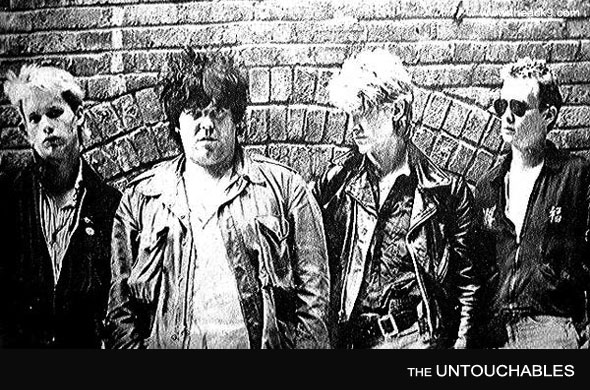
Why was Napalm Beach buried?
Let’s start with the obvious. They were underground. The music was rock, but beyond that, it was diverse, hard to pin down. They were mature (virtuoso) musicians in an amateur punk scene. They were raucous, headstrong, hard to reach. They didn’t think much about business. They just wanted to play live, record, and release albums. By the late 80s, they were all known drug addicts. That was the point that they became involved with Flying Heart, a tiny Portland “label” which did little but try to control them with favors, drugs, lies, and tiny bits of cash exchanged for recordings and publishing rights.
Also, except for a few well-received European tours, and a couple years in San Francisco, Napalm Beach never played a show outside the northwest. They spent their career (1980-1996) opening for touring bands, playing little gigs all around the northwest, and headlining at punk and rock clubs in Portland and Seattle, again and again and again.
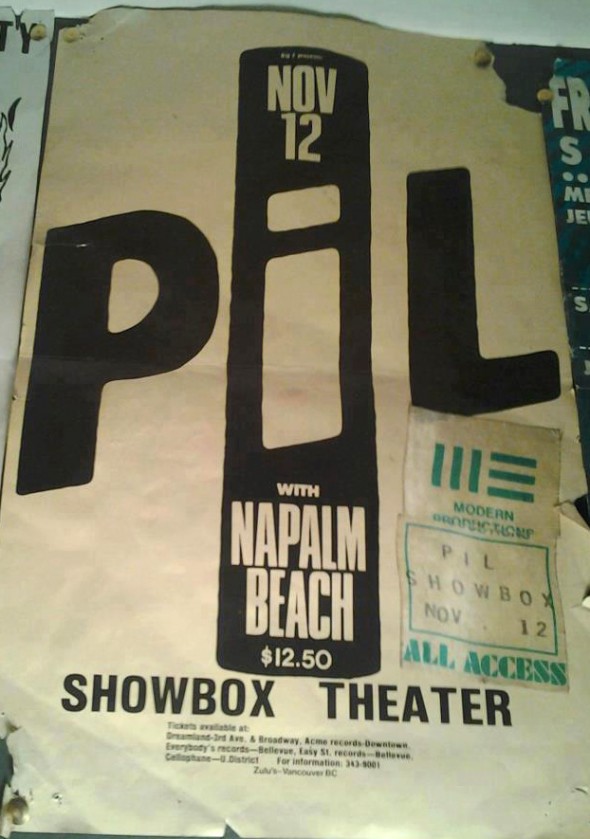
They were ahead of their time. They were dangerous. They were from Portland. They didn’t sign to Sub Pop. Their catalog was scattered, and by 1998 the bandleader was living on the streets in a cardboard box. These could all be factors.
Nonetheless, there is a reason why Zeno Records continued to quietly market their music into the 21st Century. And there is a reason why they were inducted into the Oregon Music Hall of Fame. And there is a reason why, when they broke up (after 15+ years and many albums), their fans demanded and attended reunion shows for almost two decades afterwards.
It wasn’t because they sucked.
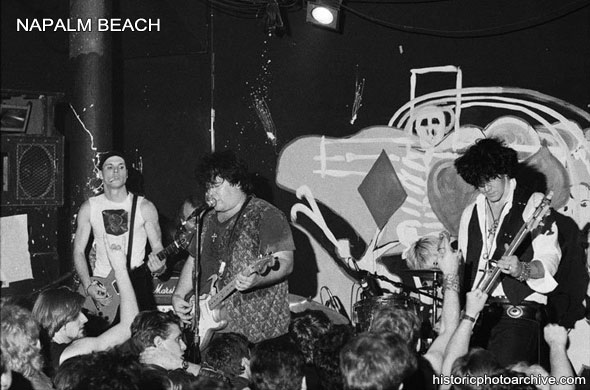

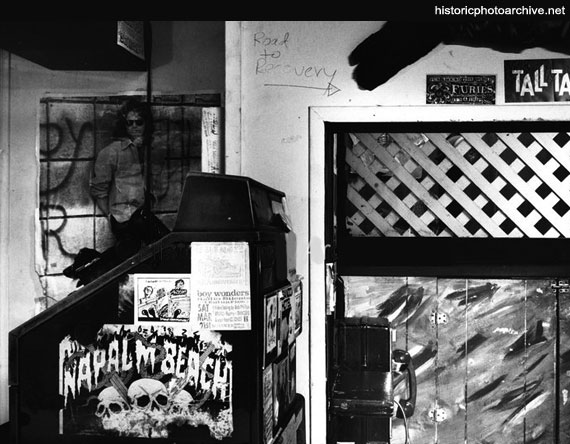
From when punk had no rules
Like most American punk scenes, the Portland punk scene materialized in 1977 immediately after the Ramones blasted through town. The Portland punk attitude was (and is) about throwing out old rules and starting something new. That is why such diverse art sprang from it. Napalm Beach, in 1980, seemed to drop straight from the sky. They actually came from Longview, Washington. They arrived in Portland ready to rock and conquer. They connected quickly with the Wipers.
Like the Wipers, Napalm Beach was fronted by an older songwriter, Chris Newman, who, at 27, had been playing guitar since the 60s, and who was excited about the idea of creating a new type of music. Like the Wipers, Napalm Beach songs were influenced by psychedelic rock.
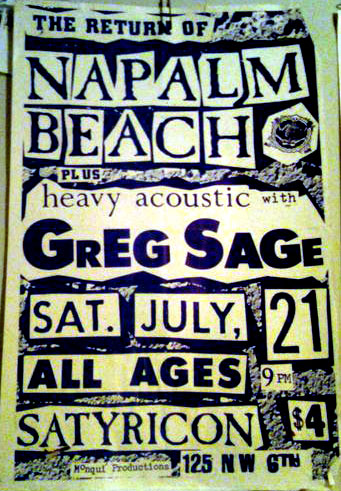
The Wipers’ Greg Sage was a creative and experienced recording engineer, and a respected figure in the Portland underground. He helped Chris record his first albums, asking for no money, and allowing Chris to keep all publishing on his music and art. When an album made money, Sage paid royalties.
In 1983 Napalm Beach opened the Wipers’ Over The Edge album release show. In 1986 Greg had Chris paint the album cover for his album, Land Of The Lost, which he would release on a new punk label, Restless Records. When the label didn’t think the image of cartoon dinosaurs roaming the ruined streets of Portland was “punk” enough, Greg suggested that Chris add a human skull in the middle. That is what made it punk enough for them.
Restless Records has since been consumed by Warner Brothers, and many of its titles are now out of print.
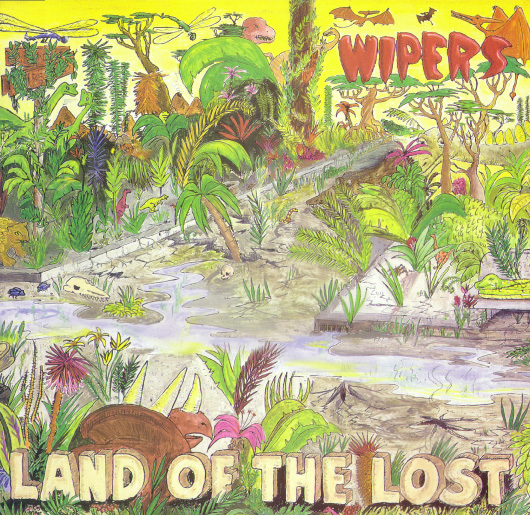
Napalm Beach lyrics and vibe were party-oriented at first, sometimes ridiculous (seriously. this is rock n’ roll). Later they grew darker, heavier, more autobiographical, and more confessional. Chris has never shied away from writing a quiet song, a love song, or playing an audacious Hendrix-tinged guitar solo. Sonically, Napalm Beach was intense, expressive drums (that’s Sam Henry – until October 1981 Untouchables/Napalm had Chon Carter who’s simpler new wave style and can be heard on Trap Sampler, where he played on both the Wipers and the Untouchables cuts ) fuzz, feedback, solid bass riffs, searing guitar (that’s Chris). They also wrote quiet melodic songs. They drew from many sources. The music never stayed still long.
They recorded many albums. At first they recorded with Sage, then they self-recorded on 4-track, and later in various low-budget studios in Oregon and Washington. They recorded two albums in Germany. To save costs, Chris learned early on how to record and mix a full-length studio album in 2-5 days. Napalm Beach made some great albums on an ultra-low budget, but they were an exceptional live act.
Through all of the 80s and into the mid 90s, Napalm Beach played original music in Portland, Seattle, and surrounding areas.

Once they began to tour Europe in 1989, they played fewer local shows. Once Nirvana broke through the stratosphere in 1991, nothing was quite the same.
Also, there was an early 80s lull. In Seattle, the Gorilla Room closed in September 1981, the Wrex February 1982, and the Showbox March 1983. Meanwhile, in Portland, The Met closed in January 1983.
The Gorilla Room had closed because of multiple liquor law violations. Underage patrons found onsite included Duff McKagan and Chuck Biscuits (Humphrey 68). Napalm Beach (who were still called the Untouchables) closed down the Gorilla Room. The place was packed and everything and everyone was sloshing under a layer of beer. They partied until they passed out onstage. That was the end of the Gorilla Room.
As for Portland, Napalm Beach had ruled The Met[1], a popular all-ages hangout, through 1982. Courtney Love was a regular there. It is where Chris met The Cramps, and saw them perform. Napalm Beach and everyone partied at The Met on New Years Eve 1982, not knowing that on January 1, 1983, the doors would close for good.
At that point the scene seemed to have dried up, at least as far as good places to play original music. This is when Napalm Beach decided to move to San Francisco (they ran into Courtney down there too). They did return to Portland and Seattle to play a couple out-of-the-way gigs, and to record Rock & Roll Hell with Greg Sage. 1983 is also when a punk club called Satyricon opened in Portland.
Satyricon’s philosophy was “a free stage for all”. Painters, poets, performance artists, film makers, street crazies, and musicians all gathered and collaborated there. When Napalm Beach came back for a visit in February 1984, they saw a revitalized underground scene. That is what inspired them to return to the northwest, which they did, summer 1985. They moved back to Portland and continued to travel to Seattle for gigs. They played Seattle’s Bumbershoot Festival in September and Johnathan Poneman’s KCMU benefit show (Live from the Rainbow) on October 18.
1985 is the year Jonathan Poneman moved to Seattle, Washington. In 1986 he joined forces with Bruce Pavitt who, in 1980, had started a zine Sub Pop. With help from friends in the Seattle scene, Poneman and Pavitt began to turn Sub Pop into a record label, and a brand.

Chris Newman and the northwest fuzz-wah continuum
One of the things that is sometimes exasperating is watching people try to figure out where, when, and how northwest punks began to incorporate elements of 60s and 70s psychedelic rock. Most writers credit Mudhoney (and their generation) for these innovations. That’s because Chris has been left out of the story.
If you look at west coast underground rock as a continuum, as I do, Jimi Hendrix had a tremendous impact. The power trio, the bass and drums holding down a solid groove while the guitar goes crazy with feedback and noise – Jimi was the innovator. Jimi’s main effects were fuzz and wah. However, fuzz tone had fallen out of fashion in rock music by the 70s. The Cramps, and Chris Newman, brought it back.
Here are some things I know about Chris as a musician. He has a sharp memory, an ear for melody, and a natural ability to arrange instruments. In addition, he has a driving need to express himself verbally, and through his guitar, and to embody all that is REAL, and all that is rock’n’roll. Simply put: it is his calling.
He grew up in a tight-knight evangelical Christian family. When he began to play, they told him he was playing the “devil’s music”. And he literally believed he could burn in hell for playing it. And he deliberately, consciously, decided that he loved rock’n’roll music so much that he was willing to burn in hell for it.
And then he did burn in hell for it. When he came out of hell, he was still playing, better than ever.
That’s how seriously he takes his music.
He is foremost a guitarist and songwriter, but he also plays bass, drums, keys, whatever. He got his first acoustic guitar at age 13 and his first electric at 14. He was also 14 when acquired his first effect pedal: a Fender Fuzz-Wah. Because, Jimi Hendrix.
At 17 Chris mowed lawns to save up money for an Electro-Harmonix LPB1 distortion pedal which he purchased from the classifieds in Rolling Stone (Issue #2). That was his introduction to Electro-Harmonix. In 1969, Electro-Harmonix developed the Big Muff π. Supposedly Jimi Hendrix was the first musician to buy a (work in progress) Big Muff – but Chris must not have been far behind, because ever since the early 70s, the Big Muff fuzz and Crybaby wah have been his main – and usually his only – effects.
In the 80s – especially the early 80s – Chris also used an Electro-Harmonix Small Clone chorus pedal. The chorus effect was invented in the late 70s. Chris bought a Small Clone in 1980 (likely about the time it first came out), incorporating it into his sound immediately. (You can hear it, for example, on these albums: Trap Sampler, Rock & Roll Hell, and Pugsley.)
Years later, these combinations of effects would become associated with Mudhoney (fuzz/wah) and Nirvana (distortion/chorus).[2]
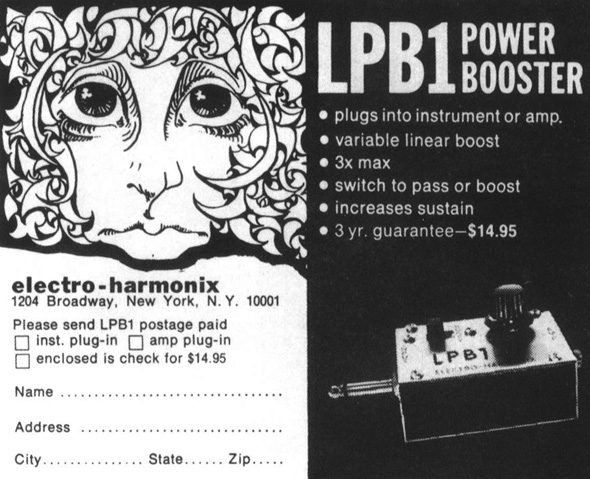
As for guitar and amp, in Napalm Beach, Chris started out playing his pink fender Strat (that matched his pink converse high-tops) through a Marshall stack. Later, and for many years, his main ax was an old Gibson Flying-V bought from Fred and Toody’s Tombstone Music store.
After seeing the Cramps in 1982, and their original two guitar, Fender Twin reverb-and-fuzz attack, Chris added a Twin Reverb amplifier to his setup. He refashioned a headlight dimmer switch to an amp switcher. For his Napalm Beach shows he could now use the switch to select either the Marshall, or the Twin, or both amps together.
Snow Bud and Sub Pop
For Snow Bud and the Flower People, the pothead joke band developed in winter 1985, Chris drew on the Cramps’ influence, stripping down to Twin Reverb, Big Muff, wah, and solid, primitive drums. Snow Bud’s first show was in Portland at Satyricon, January 28, 1986 (the Space Shuttle Challenger had blown up that morning). Unlike the Cramps (more like Hendrix), early Snow Bud songs featured heavy hooky bass riffs. For early live shows, Chris put Sam Henry on bass and (future) Dead Moon drummer Andrew Loomis on drums. Later Snow Bud became its own band, with Nathan Jorg on bass and Lance Paden on drums, a lineup which lasted from 1993 to 2013.

Snow Bud’s first two cassettes, a bunch of songs that were written title-first in a single night (Killer Bud, Bong Hit, No Shake, etc) were popular with the underground kids. Chris sold a couple dozen at each of his first two Seattle shows (early ’86), and they were sold in independent record stores around Seattle, Portland, and eventually, San Francisco.
At one of those first Seattle Vogue shows, Green River frontman and KCMU DJ Mark Arm arrived as Chris was setting up his gear. Mark carefully examined all of Chris’ gear – the Fender Twin Reverb, Big Muff and wah that he used to get his signature Snow Bud (now – sans wah – Boo Frog) tone.
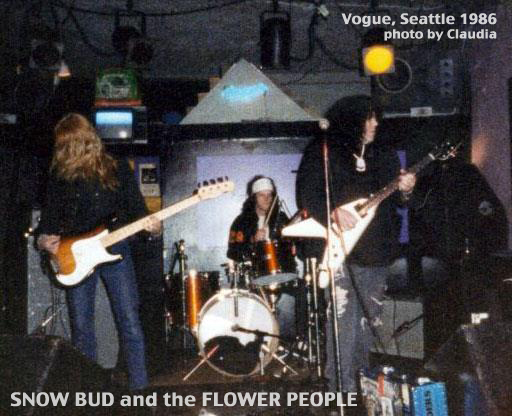
After the show, Bruce Pavitt found Chris backstage. Pavitt introduced himself and said he had a new label, Sub Pop, and that he was interested in Snow Bud. Chris said, “Sounds great”, and put the Sub Pop business card in his pocket. He didn’t have a manager at the time, or a phone, and he never called Sub Pop.
Sub Pop’s first records were Sub Pop 100 comp (1986), and Green River Dry As A Bone (1987). Meanwhile, Mudhoney had acquired and was using the Fender Twin/Big Muff combo by 1988. It is an integral part of their tone to this day.
(Gift, of course, is German for “poison”)
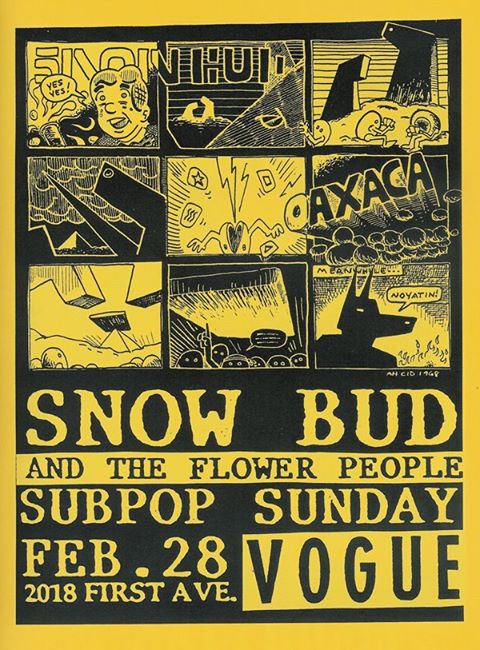
Was it unfortunate for Chris that he never signed with Sub Pop? Probably not.
I know that for most of his career, Chris didn’t think about his music in a strategic, businesslike way. He understood early on that he wouldn’t get rich or famous playing punk rock in the northwest, so he stayed busy playing to enthusiastic crowds in alternative clubs and all-ages venues. He lived gig to gig and record to record. He moved around a lot, didn’t have a phone, and relied on others (not all of whom were trustworthy) to relay messages to him.
Not to mention, Snow Bud was a joke band (that somehow lasted 27 years). It was supposed to be a side project, not an identity. And in the late 80s, I don’t think that either Sam or Chris would have handled fame or money well. So there should be no regrets about any of that.
My only issue, as far as Seattle is concerned, is that Chris, Snow Bud, and Napalm Beach have all been deleted from the narrative of 80s northwest underground music, especially when it comes to Seattle. That’s not accurate, and it’s not right.
Sometimes I wonder if it’s an old rivalry that keeps everyone amnesiac.
In the early 80s, Napalm Beach opened for national touring acts in Seattle such as Johnny Thunders And The Heartbreakers and X in 1981, and PiL in 1982. Some Seattle punks were angry about that. Seattle bands at that time didn’t have the chops or songwriting skills that Napalm Beach had. Seattle punks gobbed Napalm at PiL[4] and threatened to riot at Johnny Thunders[5].
Napalm Beach might have made some enemies.
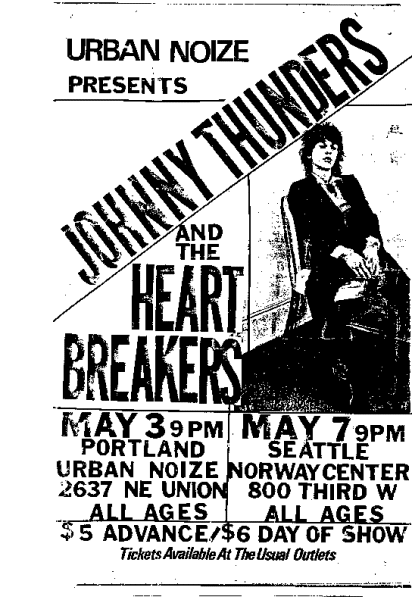
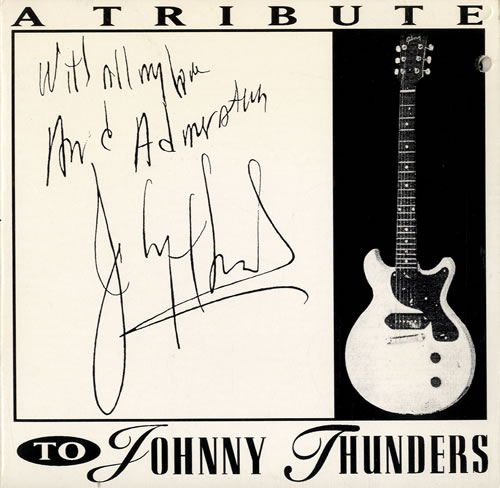
Bodhi (from the verbal root budh – to become aware, notice, know or understand) is the understanding possessed by a Buddha regarding the nature of things. It is traditionally translated into English with the word enlightenment and literally means awakened. (from Wikipedia: Bodhi)
1966-1980
In 1966, as soon as Chris got his first guitar, he was writing songs. He wrote the main riff to the song ‘Why Do Parties Have To End?’ when he was 13. At 14 he brought his guitar and fuzzbox to Christian boarding school. It was 1967 and he wanted to be a hippie. Underground. A head.
Chris grew up in Seattle, New Orleans/Mississippi, San Jose, and Longview (town of his birth). In 1972, at the age of 19, he joined a Longview hippie band called Bodhi. He was their youngest member as well as their lead vocalist and lead guitarist. Bodhi was intent on working the northwest club circuit, which meant a strict limit on originals. (The fact that they played any original music at all made them stand out.) Chris and bandmate Spyder wrote the originals, but mostly Bodhi covered psychedelic underground hits – music by acts like Deep Purple, Black Sabbath, Spirit, Hendrix. Bodhi lived in a house together, ate hippie food, smoked homegrown weed, had plenty of gigs.
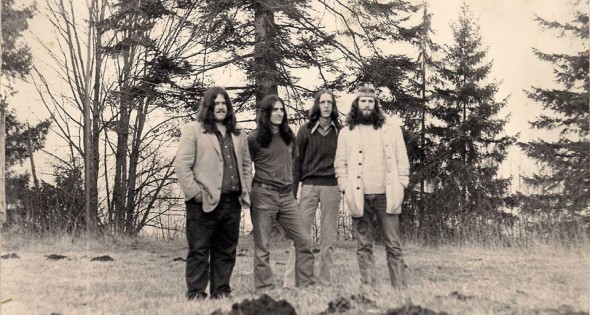
A year and a half later, Chris had fallen hard for the New York Dolls and glitter rock. So he left Bodhi to form his own glitter rock band. This new band would play nothing but originals. The cover-band club gigs fell away. They went to Santa Monica for a few months to try and “make it”. They lived on the beach in Malibu, did acid, jammed, starved, partied, were thrown out, and finally returned to Washington to start again.
Chris began to date a woman who worked in a record store. One day she brought home Iggy’s Metallic K.O.
He became enamored with, and began to study, Iggy, and the Stooges. Soon there was a buzz in the air about the “new wave”. When the Ramones played the Portland Paramount in 1977, Greg Sage, Chris Newman, and everyone else bought a $1 ticket.
The Ramones’ set was blistering.[6] They got horrible reviews. Chris thought “I’m going to start a punk rock band”. By this point he was an accomplished musician with 10 years of experience on guitar. But he loved the primitive abandon of punk, and the idea of throwing out the rules. When he started his punk rock band, he didn’t think about anything but playing what he wanted, the way he wanted to play it. He incorporated pop, glitter rock, garage rock, psychedelic, and new wave. This was 1979, and that band, first called the Goners, then the Untouchables, would eventually move to Portland, pick up the Wipers’ original drummer, Sam Henry, and become Napalm Beach.
1979
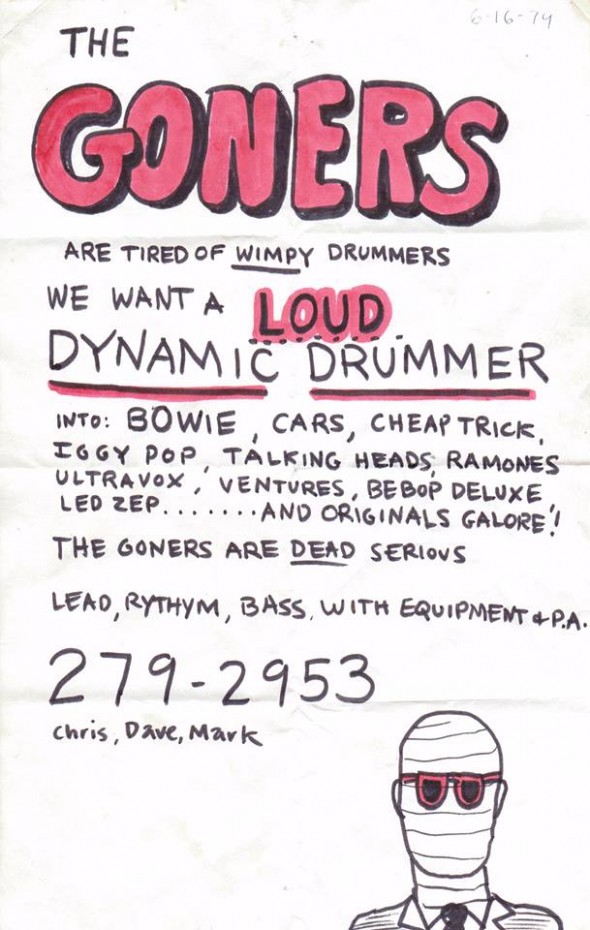
1980s
There were groups like the Blackouts from Seattle who were being completely ignored, and then from Portland you had Wipers, who to this day I think are one of the greatest rock bands in the history of American music, who were putting out their own records and being completely ignored because they were from Portland. They did not have access to media. – Bruce Pavitt, to Pitchfork. July 7, 2008.
In 1980 the Untouchables moved from Longview to Portland and got straight into the punk scene. It was a scene that included bands like Pell Mell, Styphnoids, Smegma, Sado Nation, Wipers, and Neo Boys[7].
The Untouchables immediately caught the attention of local ‘music biz’ types who were scouting the underground for potential radio-friendly acts (“They wanted me to be the next Quarterflash.”) Chris did not like these smarmy types. He wanted success, but under the circumstances, he didn’t expect it. He wanted to make music with no rules. He didn’t want to give up his individuality. To ‘make it’, they would have moved him to New York or Los Angeles (because that is how it was done), and they would try to make him get skinny (impossible), change his image, change his music. He didn’t want to do it. At the same time, Chris is an artist, and he wanted to record, and to be heard. So Greg Sage offered to record and release the Untouchables, helping them bypass the commercial system. Then, when a copyright dispute came up over the “Untouchables” band name, Chris renamed the band “Napalm Beach” to make it sound more underground and less commercial.[8]
In October 1981, after Napalm Beach had recorded the songs for Trap Sampler, Sam Henry left The Rats[9] to join Napalm Beach. Sam is partly blind, holds his drumsticks like a jazz player, loves Buddy Rich, and like Chris, is a lifelong musician. Before The Rats, Sam had been in the Wipers. It is Sam’s drumming you hear on the Wipers’ first LP Is This Real (1979) and on the Alien Boy EP (1980).
As far as Napalm Beach bassists, they came and went every few months, at least before 1989 when Dave Dillinger joined and stuck around. Chris writes (in varying levels of detail) all instrument parts to his own songs.
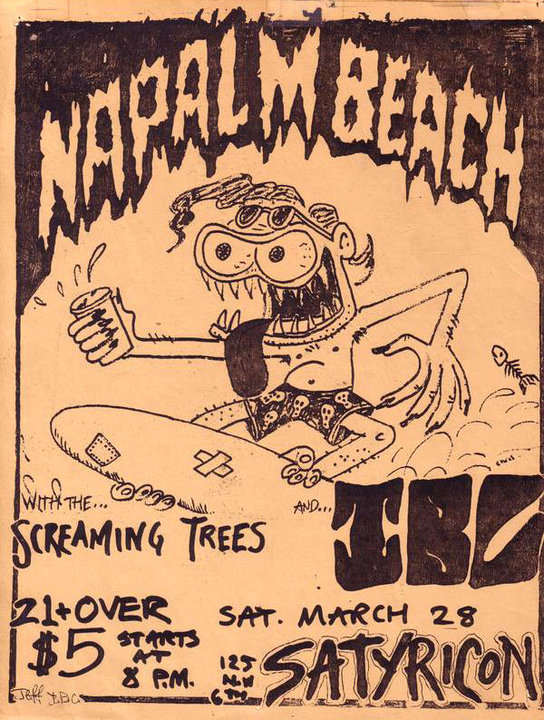
Here is how someone remembers Napalm Beach in the mid 80s:
From the standpoint of a local fan, the Teen Dream period from 1985 to 1986 marked the peak of Napalm’s success. They played the summer Bumbershoot Festival at the Seattle Center two years in a row, the first year on the large outdoor mural amphitheater stage, and the second year on a large indoor stage…
The highlight of a Napalm show at the Central in these days was always when they played “Road to Recovery,” usually in about the middle of their set… the audience would wait in nervous anticipation for the climax of the night.
…“Road to Recovery” was a roller coaster ride of alternating slow and fast, mellow and heavy. Climbing gradually up to the summit, with Chris quietly mumbling lyrics over a deceptively repetitive, hypnotic guitar riff, an intensely wild Sam Henry drum solo suddenly breaks out from nowhere raising Keith Moon’s ghost from the dead, the guitars hit a perfectly synchronized power chord, Chris belts out the lyrics’ chorus like an opera singer shouting, “I’ve got to stay alive, for the sake of rock and roll!”
— Eric N. Danielson, “On The Road to Recovery”[10]
Seattle
“It’s got death in it. For someone like you, it probably appears to be a nice town. Like it’s all holistic and trees and arboretums. Bullshit!” – Courtney Love (Yarm p 216)

Seattle is not a cultural emerald surrounded by vast oceans of nothing. A more accurate analogy would be to see the Pacific northwest as a cultural watershed, with Seattle as a river’s mouth. The water doesn’t originate there, it flows in from other places and mixes there. There is and has always been plenty of cultural connection between Vancouver, Seattle, Olympia, Portland, and the smaller towns that feed in. Nonetheless, the mythology developed by Sub Pop in the late 80s and carried forth by the rest of the world to this day doesn’t recognize this.
Grunge mythology rarely recognizes a single pioneering act from Portland outside of the Wipers (for their influence on Kurt Cobain) and Courtney (for her influence on Kurt Cobain). Not surprisingly, Sub Pop only recognizes artists in which it is invested.
Considering that Portland’s punk/music/art scene blossomed before Seattle’s, and considering that you can easily drive from Seattle to Portland and back in a day, it seems strange to me that no one has looked deeper.
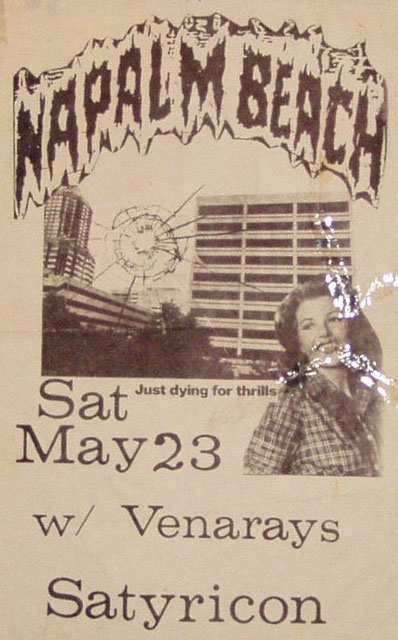
Napalm Beach and grunge
GRUNGE is a brand. It was created by Sub Pop (including members of Green River). If Napalm Beach or Snow Bud had recorded with Jack Endino – as they should have, because unlike most 80s producers, Endino understands their roots music, the 60s heavy underground – and put the album out on Sub Pop, they would have been a grunge band. But they didn’t, so they aren’t. Even though it can be argued (as I am doing) that Napalm Beach, as much as anyone, started the whole thing, they have never been included in the narrative. Mudhoney started grunge. Why? Because they were the first grunge band. The logic is flawlessly circular.
Grunge is problematic not only because it is proprietary, but also because it breaks down quickly. It’s undefinable. It’s not really a style, it’s not really an attitude, and it’s not really a genre. It’s not really anything. So why do we keep talking about it like it’s something?
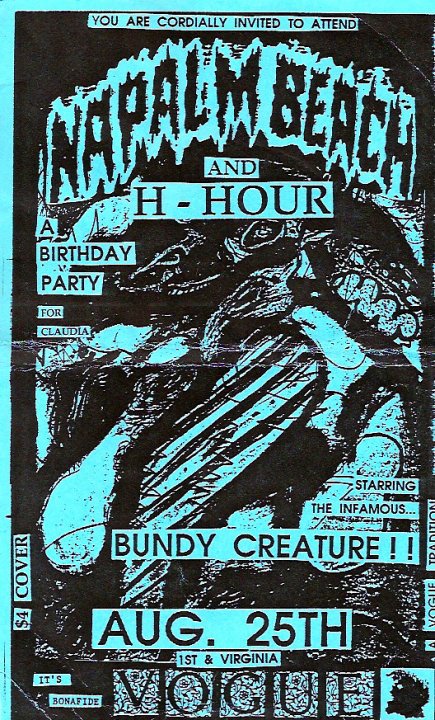
And who is really from Seattle? Although Sub Pop is a Seattle-based label, none of the Sub Pop executives associated with the origins of the label (Pavitt, Poneman, Jasper) are from Seattle, or even from the west coast. Bruce Pavitt was born in Chicago, Illinois. Pavitt moved to Olympia for college around 1979, and then he moved to Seattle in 1983. Jonathan Poneman was born in Toledo, Ohio (near Detroit) and moved to Seattle in 1985. Current Vice President Megan Jasper is from Amherst, Massachusetts, a college town on the east coast about 5,000 km from Seattle. (Where Dinosaur Jr. comes from.) She moved to Seattle in 1989.
It is not unusual for new-in-towners to see and appreciate (or laugh at) things that locals miss. That said, it is really hard for me to understand why writers and journalists accepted, and continue to accept, the original Sub Pop executives, and their closest friends, as the go-to experts on nearly everything northwest. By now Sub Pop’s original grunge mythology is so entrenched that latter-day attempts to add broader view are consistently brushed off as unimportant.
The more powerful write the less powerful out of history. I get it. I just don’t accept it.
Underneath grunge, and everything around it, there truly is something beautiful and real. The silliness and seriousness and vitality in our punk/underground. Seattle, Olympia, and Portland are very different towns, but geographically close and deeply connected.
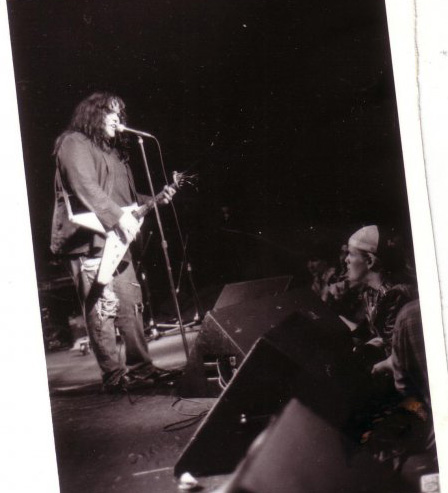
The punk rock aesthetic was interpreted by different people from different parts of the northwest, all of whom partied together, dated each other, dated each other’s ex’s, traded cassettes with each other, wrote each other letters, read each other’s zines and journals and graffiti, played music together, hated each other, liked each other, went to the same shows.
Through their constant live performances and numerous underground cassette releases, Napalm Beach won many northwestern teens to their cause of ROCK N ROLL! In Seattle, they came on like gangbusters. They had no real competition at first. They played The Wrex (which became The Vogue), The Gorilla Room, Astor Park, Off Ramp, Golden Crown, Baby-O’s, Ditto’s, Central, Graven Image, and many of those big old rented halls and granges used for all ages punk shows. They played week after week, month after month, year after year. Trips to Seattle could last two weeks, with the band playing 6-10 shows in that time span, all around the Seattle area. They might play a club gig, then an after-hours gig later the same night. They were original, on fire, relentless.
In addition to playing all these shows, Napalm Beach took every possible opportunity to record. When they released an album on cassette, they sold it at their shows and independent record stores all around Portland and Seattle (and to a lesser extent, San Francisco). They were featured first on Greg Sage’s Trap Sampler LP (1981). Then Trap released Live At The Met (1983) and Napalm Beach’s first full-length album, Rock & Roll Hell (1983), on cassette. Chris recorded, mixed, and released their third album, Pugsley (1984) himself. Teen Dream was funded by then-manager Doug Reed and recorded with Bill Stuber in Seattle at Triangle Studios on 24 track. Teen Dream was released on cassette in 1985, and on vinyl (as a self-titled album) in 1986. Napalm Beach now had a vinyl LP. That meant something. And they continued to play show after show and release album after album into the northwest punk and underground rock scene up through 1996. Beginning in 1986 Chris was also performing and releasing albums with Snow Bud and the Flower People.
A quick perusal of Wikipedia tells me that Mark Arm and Gary Lee Conner turned 21 in 1983, Kat Bjelland turned 21 in 1984, Mark Lanegan, Courtney Love, and Jack Endino in 1985, Krist Novoselic and Steve Turner in 1986, Stone Gossard and Andrew Wood in 1987, Van Conner and Kurt Cobain in 1988.
It’s a fact: Sub Pop’s late 80s Seattle-based artists grew up on Napalm Beach.
Sub Pop’s LOSER
Ugly people weren’t allowed to rock before us. – Mark Arm, as quoted in Rolling Stone Sept 2011.
Part of Sub Pop’s grunge myth is the image of an underground rocker who doesn’t care about being commercial. The greasy haired “loser” sleeping on floors, the big lumberjack playing heavy riffs, the small town rambunctious kids who just don’t give a shit. They just want to rock! Napalm Beach look like the prototype for this image, for both musicans and marketers.

Here’s Charles Cross writing for the Post Intelligencer, Seattle’s main daily (morning) newspaper, 1981:
…Chris Newman looks anything but the typical pretty boy rock star… Newman sports a girth that makes managers of all-you-can-eat restaurants turn over the closed sign when they see him walk down the street. He has a wild unkempt mop of hair, a 10 o’clock shadow and on stage tonight he’s wearing a greasy black wino’s raincoat.
Newman spends so much of his time sleeping in cars and on the floors of the bars the band plays in, that his personal hygiene habits leave something to be desired. In short, he’s the type of guy that if you saw him walking down an alley, you’d high tail it in the other direction.
But tonight on stage Newman uses his gruesome body to create some of the great gruesome driving rock n’ roll. Backed by the three other young bad-boy types that make up the Untouchables, Newman breaks into the band’s signature tune “Rock & Roll Hell” and all hell breaks loose in Astor Park as the dance floor fills up and the place becomes so hot you could cook hot dogs on the roof. The Untouchables have just begun their set and from the opening riffs of their first song they have the audience riveted to the wall with their driving, highly original new wave rock…
After their set, and the two encore tunes, a magic seems broken in the hall, as if some great sword had been pulled from the stone for a few short minutes and has now been replaced… One of Seattle’s most successful established bands has just been upstaged by some of the poorest, ugliest, and most talented rock n’ rollers in town.
Charles R. Cross “Band drives stake through heart” Seattle Post-Intelligencer July 18, 1981
Ok, you’ve come this far. Let’s talk about Courtney Love.
Napalm Beach and Courtney Love
Here is Napalm Beach playing a version of ‘Rock & Roll Hell’ in Seattle around 1981/82 – in the video/slideshow, Chris wearing a beige over-sized coat that belonged to Courtney Menely who would later be Courtney Love. She wasn’t a musician yet, but she had been living in the Napalm Beach band house and she was paying attention. She travelled to Seattle at least once with the band, and by the time of Mike Leach took these photos of Napalm Beach, Courtney was probably living in the U.K., writing Chris letters about hanging out with The Teardrop Explodes and encouraging him to come over there too.
Unlike most Portland musicians, Courtney could find money for traveling and so forth. Courtney Love and Kat Bjelland were both part of the Portland punk scene, a scene that was strongly linked to underground scenes in both San Francisco and Seattle.
Between 1986 and 1992 my friend David Ackerman spent a lot of time taking photos of bands, especially at Satyricon. In recent years, I’ve helped him license photos of your favorite Seattle bands for books and T.V. David usually photographed the stage, but sometimes he photographed people in the club (usually girls). Courtney Love was in and out of Portland in the 80s. In all his many hundreds of photos, David has exactly two photos of Courtney, both at Satyricon. According to David, the photo at the beginning of this article was taken at a Napalm Beach show in 1986 (The Obituaries opened). The other photo was taken at a Mudhoney show in January 1989 (Nirvana opened).
Courtney only lived in the band house for part of 1981, but Chris ran into her on and off at rock shows through the 80s and into the early 90s. The last time he saw her was at La Luna on her Live Through This tour. She greeted him through the mic.
Chris respects her and her work.
Napalm Beach and Nirvana
If you overlay the career path of Nirvana as a trajectory up, with the career path of Napalm Beach as a trajectory down, the center of the X would occur in 1991.
In 1988 a German-born couple associated with the Satyricon club formed Satyricon Records solely for the purpose of getting Napalm Beach to tour and release records in Europe. Despite being completely new to the business, Henk and Heike were professional, well-organized, and helped open up some great opportunities in Europe. German music magazine Spex named Moving To And Fro as one of the best albums of 1988, paving the way for tours.
With Satyricon Records’ help, Napalm Beach toured the European club circuit beginning in 1989. Their first tour traveled about two weeks ahead of Tad and Nirvana’s first tour, playing all the same clubs. “We saw graffiti and other signs of Napalm Beach,” Tad bassist Kurt Danielson told me once.
Napalm’s first German performance was notorious. They had never before experienced the kind of rock star treatment they received upon arriving in Europe. The Germans handed Chris shot after shot of Jack Daniels, “American whiskey for you!” He got drunk and destructive. The next day the Nürnburg club called the Hamburg club and warned them that Chris had trashed the entire backstage area (true), and raped a woman (not true).
Hamburg said “Send them anyway!” Chris reconsidered his approach, and the rest of the tour was spectacular.
At this time, Kurt Cobain would have been 22 years old and Nirvana almost three years old. Chris Newman would have been a boyish 36 years old and Napalm Beach almost 10 years old. In 1989, Chris had been playing guitar longer than Kurt Cobain had been alive.
Napalm Beach toured Europe again in 1990. Napalm Beach were in Europe on New Years Eve 1990/91, which meant that back home, Nirvana played Napalm’s usual New Years slot at Satyricon.
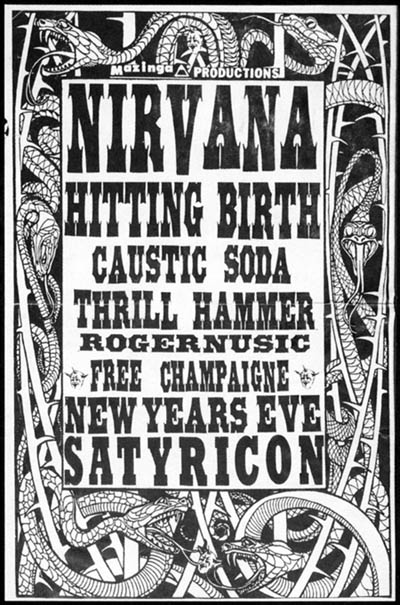
Then Napalm toured again in 1991, this time just tailing Nirvana. Nevermind began to rocket up the charts. Napalm played a beautiful club in Vienna and the owner told them how two weeks earlier, Tad/Nirvana had come through and they had to turn away 2,000 people at the door.
That is how fast everything changed.
December 1991
About 10 years ago Greg Sage revealed that Kurt Cobain took his life two weeks before his first scheduled recording session with Sage at Zeno. He said the sessions had been kept secret, something to do with Cobain’s label, and issues of control.
The story didn’t end there for Napalm Beach. They toured a bit more, they released some more albums, they made a few more mistakes.
Meanwhile, thanks to the efforts of Sub Pop, many of the kids who had grown up listening to northwest underground bands like Napalm Beach had become instant rock stars. In the process, some of Chris’ innovations in sound, stagecraft, and songwriting were attributed to younger, more famous artists. That’s OK. I think that Chris is more than proud to have been an inspiration for so many.
The problem is not the inspiration, but the omissions.
Portland Underground
…really open and weird… weird louder, arty bands, as opposed to the quiet, sweet Olympia sound. – Gilly Ann Hanner of Calamity Jane, on observing the late 80s Portland music scene after living in Olympia
Because writers and researchers have continually failed to understand the dynamics of influence and competition between Seattle and neighboring towns, images of late 20th Century northwest rock music are consistently filtered through a Seattle/Olympia-slanted lens. 80s Portland punk/indie/alternative bands were almost all D.I.Y., and all buried under the great myth of grunge. Pioneering rock bands like the Obituaries and Calamity Jane became little more than a footnote in the Nirvana story. And a band like Napalm Beach just disappears completely.
Some seem to think all the invisibility kept Portland “pure” – but what musician wants to be invisible? or pure? or unheard?
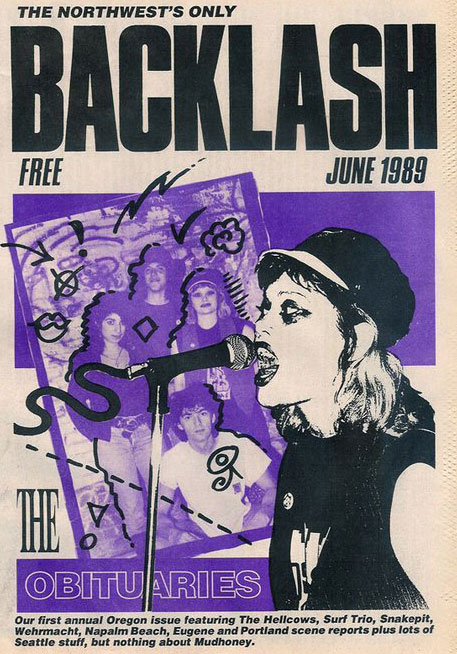
1996 to today
In 1996 Chris arranged and performed a tribute show in honor of Jeffrey Lee Pierce, who had recently passed away. He performed the entire Fire Of Love album. The following day, Chris was arrested for heroin possession, creating a cascade of events that ultimately led him to become homeless, losing everything – letters, records, original artwork, and years of journals detailing band experiences. At this point, he had effectively given up and resigned him self to the life, and death, of a street addict. He and his wife Valarie lived on the streets, mostly in San Francisco, for six years. He wrote and recorded two albums while homeless.
Ultimately, Chris and Valarie, both addicts, had to divorce in order to survive.
Chris spent about 25 years of his life struggling with heroin. He eventually served his time in jail and has been back in Portland actively working on his recovery for over a decade. He has been clean of heroin for over three years now. As long as he has love and stability, he won’t go back. Sam has been off heroin for 10 years, and will soon tour Europe for the first time since the 90s, with his band, Don’t. Bassist Dave Dillinger is also clean and well and has recently married. Chris’ ex-wife, Valarie, a writer, and prostitution recovery advocate, is clean and sober and studying English at a beautiful liberal arts college.
Chris and Valarie are still friends, and I think she’s cool too.
In 2009, Chris arranged a Cramps tribute show in honor of Lux Interior, who had recently passed away. I asked to play guitar for the tribute, and that is how we got together. When the tribute show was over, we were left with Boo Frog.
2012
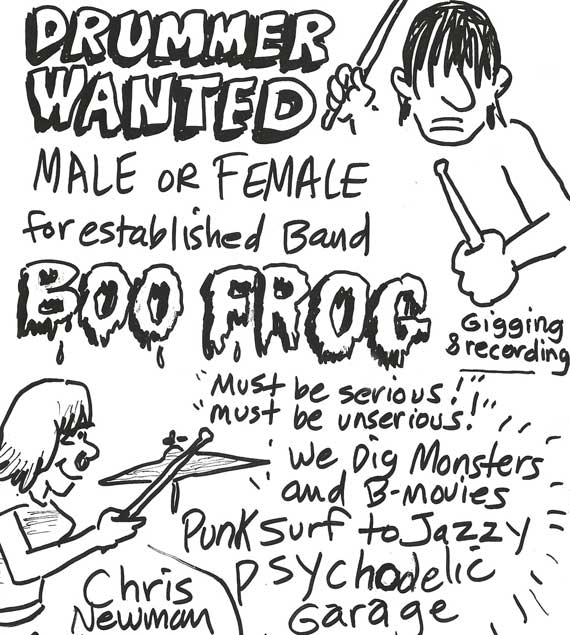
There are a lot of interweaving themes in this story, many conflicting agendas in music and society. To me, a musician, the overriding theme is the tension between commercial and independent music. I find myself ever-more respectful of what artists like Greg Sage struggled to achieve, and of the difficulties they have experienced trying to find the balance between getting one’s music heard, and losing control of it (and any income it may generate). I am also very grateful to him and to so many others who have gone out of their way to help Chris and other unusual or misunderstood artists.
Now with Boo Frog, Chris continues to write, play, and perform, and he will do so for as long as he is able. We will do a kickstarter to release Boo Frog’s third album. We are writing our fourth album. We also hope to raise funds to remix and rerelease Teen Dream, out of print since 1986. We will do as much as we can.
Chris’ songwriting continues to be prolific. He’s always weaving in new ideas. He still plays guitar every day. He has not toured since 1992 and very much wants to tour again before his health fails. He is still a top-notch performer, still gives EVERYTHING each time he gets on stage. He still approaches music and life with the openness and passion of a child who has lived long enough to know that where the old path ends, a new one begins.
Footnotes
[1] Portland and Seattle have had some similarly-named locations and venues. There was a Portland Metropolis (called “The Met”) and there was a Seattle Metropolis. Both were all-ages alternative clubs in the early 1980s. The Met (Portland) was a gay dance club that started having live music in 1981, got overrun by new wave kids, and closed January 1, 1983. It was downtown where Dante’s is today. The Metropolis in Seattle opened in 1983, was cooperatively run, and lasted nine months (Humphrey, 87).
[2] Kurt Cobain’s signature effects were a Small Clone chorus and a Boss distortion pedal (DS-1) that sounds a lot like the MXR distortion pedal which was an early Wipers sound.
[4] It appears that both Steve Turner and Mark Arm were both at the 1982 PiL/Napalm show. “I met Mark in October of ’82, right when my senior year started… we could never really decide if it was the Public Image Ltd show or the TSOL show where I met him in line.” Steve Turner, as quoted in Everybody Loves Our Town (Yarm, p 45.) Green River got their chance to open for PiL in 1986. This show went down in history for the “welcome” shown to PiL by Green River and co, and many people believe it inspired Lydon’s 1987 song, ‘Seattle’.
Mark: Yeah, it was pretty out of hand, but it was a reaction to seeing someone that you respected at one point turning into something that you imagine that at one point he hated.
Steve: I never respected him at any point, really.
Mark: The first three records are great. I saw them a long time ago and it was an amazing show.
(Maximum Rock n’ Roll, August 1990)
[5] Untouchables opened for Johnny Thunders in Portland and Seattle Spring of 1981. At the Portland show, future Napalm Beach bassist Otis P. Otis (also mentioned in footnote #7) traded his Gibson Les Paul Jr. for Thunders’ duct-taped together (but autographed) L6 guitar.
According to Grunge Is Dead, the U-Men picked up their singer, John Bigly, at the Seattle Johnny Thunders show (Prato 54). It was an all ages show in a rented hall. The Untouchables let the Heartbreakers use their backline. Untouchables played a great set, but Johnny Thunders spent most of his set backstage doing drugs. Finally the Seattle punks lost patience and rushed the stage, shouting “Johnny Thunders sucks!!! Untouchables suck!!! Fuck you!!!” and looking like they were going to rip the stage apart. Johnny Thunders’ two travelling thugs then beat the crowd back from the stage with microphone stands and so forth, until the show was shut down.
Chris met Thunders one more time after that, on tour, in April 1991, while playing Xtasy Club in Berlin. Chris and Sam spotted Johnny in their hotel and invited him to breakfast. At this point, Thunders was touring with a sax player, playing to tiny crowds. He was alone and seemed down but cheered up as they talked, especially when Chris told him how much his music had meant to him. He told Chris and Sam that he was on his way to Hamburg where he would record with the Toten Hosen, and then use the money from the session to buy a ticket to New Orleans where he hoped to start a band with “a horn section and black chick backup singers” (Johnny’s words). He signed a blank page in Chris’ passport “with all my love and admiration”, before they parted ways.
Thunders died in New Orleans three day later.
Unlike what Wikipedia (currently) says, it appeared to Chris that, in Berlin, Thunders had been using heroin, and plenty of it. (No one knew he had been suffering from leukemia.) This does NOT make his death any less tragic or or the circumstances around it any less criminal.
[6] Here is an essay about that Ramones show featuring Otis P. Otis who came from Seattle to play guitar on the final ‘Why Do Parties Have To End?’ and who still looks spectacular. Writer Marc Covert also conducted this Greg Sage interview.
[7] Neo Boys were a fierce all-female Portland punk band. I do not think they ever toured. Neo Boys drummer Pat Baum is also a filmmaker (now a marine ecologist) who worked with both Greg Sage and Gus Van Sant. She helped Chris with a lot of cassette duplication over the years, and she documented Napalm Beach on film. She is the reason why we have beautiful live footage of Napalm Beach in 80s Portland. THANK YOU, Pat Baum.
K Records is preparing to re-release some Neo Boys music. Just before submitting this article, we received a message from Pat Baum saying that the release date will be October 14, 2013. (check back here for more information).
[8] Greg Sage recorded and released Napalm Beach on the Trap Sampler LP (1981). Then he released Live At The Met and Rock & Roll Hell on cassette (1983). Sometime around 2000 Sage added Live At The Met tracks to Rock & Roll Hell and sold it from his website on CD until about 2010 when Chris began to regain control of his catalog.
[9] The Rats was Fred and Toody Cole’s first band together. Fred and Toody’s best known project was Dead Moon. Their current project is Pierced Arrows.
[10] Eric Danielson’s “Road To Recovery” article somehow disappeared off of the web between the time I started writing this essay and the time I finished it. Danielson worked very hard on compiling a history and a good discography. Eric was a Seattle music fan in the 80s. His perception was that Napalm Beach dropped off the map in Seattle during the years they were touring in Europe (1989-1992).
Works Cited
- Humphrey, Clark. Loser: The Real Seattle Music Story. Portland: Feral House. 1995.
- Prato, Greg. Grunge is Dead: The Oral History of Seattle Rock Music. Toronto: ECW Press. 2009.
- Tow, Stephen. The Strangest Tribe: How a group of Seattle rock bands invented grunge. Seattle: Sasquatch Books. 2011.
- True, Everett. Nirvana: The Biography. Cambridge: Da Capo Press. 2007.
- Yarm, Mark. Everybody Loves Our Town: An Oral History of Grunge. New York: Three Rivers Press. 2012.
Photo/Video credits
